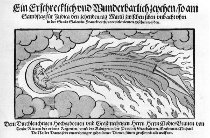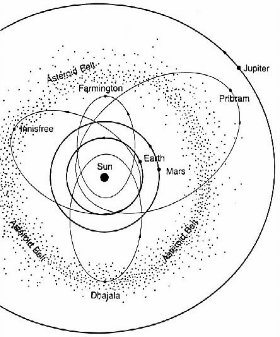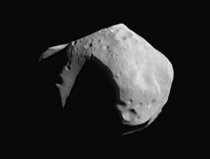 |
Origins of Meteorites
| Although Chladni convinced most scientists in the early 19th century that meteorites actually represent genuine rocks from space, nobody really knew where they came from. Did they have their origin on the Moon, on other planets, or did they
actually represent chunks of matter wandering homelessly through our solar system? Were they parts of comets or stars, or did they even stem from outer space, some place beyond the confines of our known world? It took more than a century to unlock some of their secrets, and
it required an interdisciplinary research, engaging methods of modern physics, astro-physics, astronomy, chemistry, and
mineralogy, to reveal the origins of at least some specific groups of meteorites. |
 |

Were Meteorites Lunar Rocks?  |
 |
|
 |
|
|
The Asteroid Belt
Since the late 1950s, scientists have been able to determine
the exact orbits of some meteorites, mostly ordinary chondrites,
that were photographed by several cameras during their fall -
e.g., Pribram, Czech Republic, Innisfree, Canada, and Lost City,
USA. The orbits of two other ordinary chondrites, Farmington,
USA, and Dhajala, India, have been calculated from independent
observations of their falls by eyewitnesses. Each of these orbits
has its aphelion, i.e., its most distant point from the Sun, in the
asteroid belt, located between the orbits of Mars and Jupiter,
which suggests that at least the ordinary chondrites are pieces of
asteroids.
This view is consistent with what we know about asteroids.
Most of them seem to represent undifferentiated bodies that
never accreted into a larger planet because of the perturbing effects
of Jupiter's massive gravitational field. Hence, they should be
composed of primordial matter that remained more or less
unchanged for the last 4.5 billion years - facts that hold true
for ordinary chondrites and most other meteorites. Today, it is
widely accepted that most meteorites have their origin in the
asteroid belt, with the members of each group representing a common
asteroidal parent body. >>
top... |
 |

Map of the Orbits of Certain Meteorites

|
 |
|
|
|
|
Asteroidal Meteorites
Actually, the asteroid
belt is populated by thousands of large asteroids, and yet more
small to medium sized bodies. They vary widely from each other,
so that looking for the actual parent body of a particular meteorite group is like looking for a needle in a haystack.
However, the albedo and the reflectance spectra of asteroids provide the basis for a
classification system, and they give us
an idea of their compositions. The M-Type asteroids seem to be
metallic in composition, exhibiting spectral signatures similar
to those of iron
meteorites. The C-Type asteroids are dark
bodies with nearly featureless spectra, suggesting a
carbonaceous composition. The S-Type asteroids represent a
spectrally diverse class that probably includes both chondrite
and achondrite parent bodies.
Researchers have thoroughly compared hundreds of individual
asteroid spectra to meteorite spectra since the late 1980s. In
some cases, they found strong similarities, suggesting that a
certain asteroid might be the parent body of a certain meteorite
class. In other cases, however, they found a close match, as
for the H chondrites and the S-type asteroid 6 Hebe,
named for the Greek goddess of eternal youth. Another
prominent example is 4 Vesta, one of the largest asteroids in
our solar system, which proved to be the parent body of the HED
group achondrites - the eucrites, howardites, and diogenites. The
spectral signatures of these highly differentiated rocks are as
unique as the reflectance spectra of their parent body, Vesta.
With a diameter of about 530 km, Vesta is a spherical,
differentiated body that shares many features with the
terrestrial planets, e.g. Venus, Mars, and Earth. We can resolve a
crater near its south
pole that is 460 km wide and 30 km deep - the
remnant of a huge impact that excavated Vesta's basaltic crust
down to its mantle. Due to the immense force of this impact
event, large chunks of matter were ejected from Vesta, forming
smaller asteroids of similar composition - the so-called
Vestoids. Some of these "children of Vesta"
subsequently entered a near-Earth orbit, and they are thought to
be the actual sources of the HED members that have made their passage to Earth in the form of
meteorites. To access more detailed information on this subject, have a look at our HED
page. >>
top...
|
 |

C-Type Asteroid 253 Mathilde

The S-Type Asteroid 243 Ida


Vesta - Home of the Eucrites

|
 |
|
|
|
|
Planetary Meteorites
A few meteorites have been proven to have a more prominent
origin. In the early 1980s, Japanese and American
researchers discovered the first lunar meteorites in the ice
fields of Antarctica - actual pieces of the Moon! Subsequently,
several other lunaites have been recovered from the hot deserts
of Australia, Africa, and Oman, bringing the total number of
lunar meteorites to 25, excluding all probable pairings. All of
these meteorites were found to exhibit mineral compositions
similar to the samples returned by the Apollo and Luna missions,
proving their lunar origin. However, they are of major
scientific importance because they originate from areas of the
Moon that were not sampled before. Most lunaites in our
collections have been blasted from the lunar highlands that
cover the far side of the Moon. Only a few lunar meteorites have
their origin from the smooth lowlands, the maria of the near
side, which served as the preferred landing sites for the Apollo
missions. Have a look at our Lunar
Meteorites page.
The meteorites of the SNC group are even more fascinating
since they are genuine pieces of
the planet Mars. With crystallization ages between 1.35 and 0.15
billion years, most SNC members are extremely young compared to other
achondrites. Obviously, they formed on a parent body that has
retained its igneous activity until very recent times,
suggesting that the source of these strange rocks is a planet.
In the 1980s, the discovery of trapped gas inclusions inside
several SNC members provided a final answer. Based on the data
obtained by the Viking probes, which landed on Mars in 1976, the
composition of this trapped gas is more or less identical to the Martian
atmosphere,
convincing most scientists that the members of this group
actually are genuine samples of our red neighbor, the planet
Mars. Consequently, the SNC members are also known as Martian
meteorites. Have a look at our Martian
Meteorites page to learn more about these most unusual rocks
from space. >>
top...
|
|

The Home of Lunar Meteorites


The Home of the SNC Group

|
|
|
 |
|
|
|

|